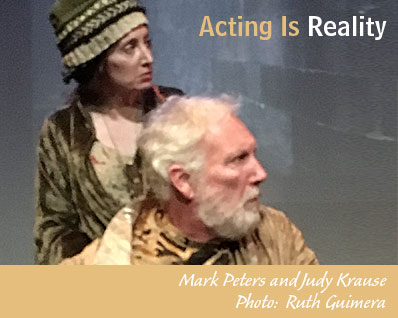 John Strasberg calls the fifth of his Nine Natural Laws of Creativity the Law of Spontaneous Inspiration. It is perhaps not accidental that spontaneity is in the center of the nine laws. Having worked and studied with Strasberg for more than a decade, I can testify that spontaneity is at the heart of his teaching and artistic “way.”
John Strasberg calls the fifth of his Nine Natural Laws of Creativity the Law of Spontaneous Inspiration. It is perhaps not accidental that spontaneity is in the center of the nine laws. Having worked and studied with Strasberg for more than a decade, I can testify that spontaneity is at the heart of his teaching and artistic “way.”
Training to achieve spontaneity may sound like an oxymoron. How can one consciously pursue a state in which the key aspect is allowing impulses to emerge without conscious effort?
There is a quality of “refraining” – such as refraining from the kind of mechanistic thinking we’ve discussed in earlier posts – that can help create the state in which spontaneous inspiration occurs. Poet John Keats wrote about “negative capability.” Keats apparently used the term first to describe a quality of writers such as Shakespeare, whose work followed an artistic vision rather than mechanistic thinking. “Negative Capability,” Keats wrote, “that is, when a man is capable of being in uncertainties, mysteries, doubts, without any irritable reaching after fact and reason.”
It’s a problem has arisen and been addressed across a range of human cultures. Strasberg mentions yoga and tai chi among techniques that “integrate rather than mechanically split our perception of who we are.”
Some Zen meditation, as well, seeks to open us to inspiration – also referred to as insight. While in the West Zen meditation or zazen is sometimes associated with absence of thought, Dogen, founder of the Soto Zen tradition, taught that assuming the zazen posture, or “full-lotus position,” goes beyond mind-body dualism. Zen master Shunryu Suzuki describes it this way: “When we cross our legs like this, even though we have a right leg and a left leg, they a become one. The position expresses the oneness of duality: not two and not one. This is the most important teaching .... One body and mind are not two and not one. If you think that your body and mind are two, that is wrong; if you think they are one, that is also wrong. Our body and mind are both two and one.”
In his groundbreaking book Flow, which we introduced in our previous post, psychologist Mihaly Csikszentmihalyi identifies the ability to focus attention as a key factor in “becoming completely involved in an activity for its own sake....” Csikszentmihalyi refers to attention as “psychic energy.” When attention is truly focused on the task at hand, he writes, “people become so involved in what they are doing that the activity becomes spontaneous....” He goes on to quote a dancer describing this state: “... Your mind isn’t wandering, you are not thinking of something else; you are totally involved in what you are doing.... Your energy is flowing very smoothly....”
Another condition necessary to finding the spontaneity of “flow” Csikszentmihaly calls “the loss of self-consciousness.” “Preoccupation with the self consumes psychic energy because in everyday life we often feel threatened,” he writes. To achieve spontaneity the subject’s concentration must be focused to the point that there is not any psychic energy left over for concern with appearances or how one is judged by others.
Focus – a term Strasberg uses frequently in his in-person teaching – is a key component in reaching the level of concentration needed to achieve spontaneity. For an actor the focus can be any aspect of the world of the character or the play that offers a “way in.” Literally anything in the world of the character or the play can serve this purpose – a small detail in the playwright’s description of what the character does, says, wears; something about the setting or the environment, a piece of furniture or furnishings, an aspect of the landscape or weather, etc. As the actor re-experiences the sensations and feelings associated with the point of focus, he/she connects their everyday reality and the reality of the play.
While finding something to focus on can offer a path to deep concentration, it is not a given that an actor can achieve it, especially early on in his/her career or study. As Strasberg points out, being able to summon one’s powers of concentration in this way requires “talent, experience, and willingness to work hard.” “The belief of some so-called artists that spontaneous inspiration can only result from not thinking about what one is going to do and not developing the capacity to consciously become involved, is mistaken,” he writes. Invoking the title of his book, in an indicator of the centrality of this law to Strasberg’s whole process, he concludes that true artists “... develop their talent and the capacity to create a state of being in which the conditions for this ‘accident’ of inspiration can be habitually established, accidentally on purpose.”
